The Evaluation and Obstacle Analysis of Urban Safety Resilience Based on Multi-Factor Perspective in Beijing
Abstract
:1. Introduction
2. The Mechanism of Action of Resilient Cities
3. Methodology
3.1. Construction of the Evaluation System
3.2. Determination of Weights
3.2.1. Correlation Analysis
3.2.2. Combinatorial Empowerment Method
- Analytic hierarchy process
- 2.
- Entropy method
- 3.
- Combined Empowerment Method
3.3. Technique for Order Preference by Similarity to an Ideal Solution (TOPSIS)
- (1)
- Construct the original data matrix
- (2)
- Determining the weighting of indicators. The results of the calculation of the indicator weights in combination with the portfolio assignment method.
- (3)
- Determine the optimal and inferior solution vectors.
- (4)
- Calculate the Euclidean distance between each index value and the positive and negative ideal solutionswhere denotes the Euclidean distance from the optimal solution, and denotes the Euclidean distance from the inferior solution.
- (5)
- Proximity calculation
3.4. Obstacle Degree Model
3.5. Data Sources
4. Empirical Analysis
4.1. Determination of Evaluation Indicators
4.2. Measurement of the Level of Safety Resilience in Beijing
4.3. Diagnosis of Obstacle Degree of Safety Resilience Level in Beijing
5. Conclusions and Recommendations
5.1. Conclusions
5.2. Implications
5.3. Recommendations
Author Contributions
Funding
Institutional Review Board Statement
Informed Consent Statement
Data Availability Statement
Conflicts of Interest
Abbreviations
| Pearson’s correlation coefficient | |
| Sample mean | |
| Sample standard deviation | |
| The result of the comparison of the importance of element i and element j | |
| Consistency Indicator. | |
| Consistency ratio | |
| Research subjects (16 districts in Beijing) | |
| Number of indicators | |
| Value of indicator for jurisdiction | |
| Positive and negative indicator treatment values | |
| Calculation of the share of the -th jurisdiction under the -th indicator for that indicator | |
| Information entropy | |
| Indicator weight values | |
| Weight values obtained from hierarchical analysis | |
| The weight values obtained by the entropy method | |
| Combined weight values | |
| TOPSIS raw matrix | |
| Positive ideal solution | |
| Negative ideal solution | |
| Euclidean distance from the optimal solution | |
| Euclidean distance from the worst solution | |
| Relative proximity of each evaluation object to the ideal solution |
Appendix A
Correlation Analysis Processing Results
| Pearson Correlation—Standard Format | |||||||||||||
|---|---|---|---|---|---|---|---|---|---|---|---|---|---|
| Disaster Bearing Capacity | (1) | (2) | (3) | (4) | (5) | (6) | (7) | (8) | (9) | (10) | (11) | (12) | (13) |
| GDP per capita (yuan/person) (1) | 1 | ||||||||||||
| General public budget revenue (billion yuan) (2) | 0.692 ** | 1 | |||||||||||
| Total industrial output value as a proportion of GDP (3) | 0.362 | 0.809 ** | 1 | ||||||||||
| Total industrial output value as a proportion of GDP (%) (4) | −0.570 * | −0.471 | −0.366 | 1 | |||||||||
| Per capita disposable income of residents (yuan) (5) | 0.827 ** | 0.754 ** | 0.573 * | −0.680 ** | 1 | ||||||||
| Urban registered unemployment rate (%) (6) | 0.729 ** | 0.428 | 0.311 | −0.629 ** | 0.579 * | 1 | |||||||
| Urban per capita electricity consumption (KW·h/person) A12 (7) | −0.063 | −0.205 | −0.248 | 0.147 | −0.466 | 0.167 | 1 | ||||||
| Number of hospital beds per 10,000 people (units) (8) | 0.838 ** | 0.385 | 0.002 | −0.543 * | 0.745 ** | 0.630 ** | −0.146 | 1 | |||||
| Ratio of social safety expenditure and employment to fiscal expenditure (%) (9) | 0.4 | 0.584 * | 0.572 * | −0.597 * | 0.668 ** | 0.496 | −0.157 | 0.391 | 1 | ||||
| Medical insurance participation rate (%) (10) | 0.953 ** | 0.563 * | 0.285 | −0.617 * | 0.804 ** | 0.839 ** | −0.072 | 0.892 ** | 0.442 | 1 | |||
| Number of students in general secondary schools per 10,000 people (11) | 0.850 ** | 0.345 | 0.14 | −0.439 | 0.517 * | 0.678 ** | 0.19 | 0.707 ** | 0.153 | 0.852 ** | 1 | ||
| Resident population density (persons/km2) (12) | 0.948 ** | 0.635 ** | 0.235 | −0.611 * | 0.857 ** | 0.666 ** | −0.202 | 0.899 ** | 0.48 | 0.921 ** | 0.746 ** | 1 | |
| Natural population growth rate (‰) (13) | −0.784 ** | −0.358 | −0.16 | 0.672 ** | −0.810 ** | −0.663 ** | 0.253 | −0.889 ** | −0.478 | −0.863 ** | −0.673 ** | −0.806 ** | 1 |
| Pearson Correlation—Standard Format | |||||||
|---|---|---|---|---|---|---|---|
| Dangerous | (1) | (2) | (3) | (4) | (5) | (6) | (7) |
| Umber of accidents and disasters (cases) (1) | 1 | ||||||
| Number of fatalities in production safety accidents (persons) (2) | 0.395 | 1 | |||||
| Accident disaster direct economic loss (million yuan) (3) | 0.363 | −0.012 | 1 | ||||
| The number of accidental disaster deaths year-on-year decline rate (%) (4) | −0.057 | −0.272 | 0.098 | 1 | |||
| Billion GDP mortality rate (%) (5) | −0.138 | −0.021 | −0.085 | −0.1 | 1 | ||
| Direct economic loss rate of 100 million GDP (6) | 0.294 | −0.07 | 0.981 ** | 0.04 | −0.02 | 1 | |
| Direct economic loss per capita (yuan) (7) | 0.349 | −0.072 | 0.984 ** | 0.15 | −0.077 | 0.949 ** | 1 |
| Pearson Correlation—Standard Format | ||||||||||||||
|---|---|---|---|---|---|---|---|---|---|---|---|---|---|---|
| Emergency Response Capacity | (1) | (2) | (3) | (4) | (5) | (6) | (7) | (8) | (9) | (10) | (11) | (12) | (13) | (14) |
| Emergency management agency personnel (people) (1) | 1 | |||||||||||||
| Number of professional emergency rescue teams (people) (2) | −0.088 | 1 | ||||||||||||
| Disaster information officer (person) (3) | 0.556 * | −0.042 | 1 | |||||||||||
| Earthquake Disaster Reporters and Geohazard Surveyors (4) | 0.237 | 0.474 | 0.429 | 1 | ||||||||||
| Number of administrative law enforcement officers holding certificates (people) (5) | 0.555 * | −0.383 | 0.675 ** | 0.167 | 1 | |||||||||
| Administrative enforcement inspections per capita (pieces/person) (6) | −0.192 | −0.331 | 0.228 | −0.079 | 0.316 | 1 | ||||||||
| Workload per full-time safety officer (home/person) (7) | 0.234 | −0.552 * | −0.042 | −0.289 | 0.31 | −0.009 | 1 | |||||||
| safety inspection coverage (%) (8) | −0.029 | −0.077 | −0.054 | −0.123 | −0.314 | −0.544 * | 0.282 | 1 | ||||||
| The coverage rate of accident and hidden danger investigation and management systems (%) (9) | 0.308 | −0.396 | 0.106 | −0.205 | 0.499 * | 0.095 | 0.448 | 0.194 | 1 | |||||
| Correction rate of accidents and hidden dangers (%) (10) | −0.014 | 0.194 | −0.131 | 0.04 | 0.074 | −0.276 | −0.217 | −0.055 | 0.01 | 1 | ||||
| Coverage rate of safety risk assessment in key industry areas (%) (11) | 0.316 | −0.568 * | 0.510 * | −0.195 | 0.681 ** | 0.147 | 0.384 | −0.077 | 0.237 | −0.154 | 1 | |||
| Coverage rate of safety risk assessment in key industry areas (%) (12) | 0.005 | −0.449 | 0.047 | −0.395 | 0.33 | −0.151 | 0.259 | 0.316 | 0.487 | 0.308 | 0.257 | 1 | ||
| Number of safety training assessment personnel (people) (13) | 0.346 | −0.366 | 0.791 ** | 0.299 | 0.761 ** | 0.468 | 0.182 | 0.008 | 0.435 | −0.017 | 0.484 | 0.338 | 1 | |
| Administrative law enforcement personnel training exam pass rate (%) (14) | −0.051 | 0.047 | 0.246 | 0.166 | 0.323 | 0.275 | −0.324 | −0.372 | −0.027 | 0.3 | 0.222 | 0.066 | 0.306 | 1 |
| 1 | Pei, J.; Liu, J. Evaluation of Chinese Enterprise safety production resilience based on a combined gray relevancy and BP neural network model. Sustainability 2019, 11, 4321. |
References
- Sanghi, A.; Ramachandran, S.; Fuente, A.; Tonizzo, M.; Sahin, S.; Adam, B. Natural Hazards, Unnatural Disasters: The Economics of Effective Prevention; The World Bank: Washington, DC, USA, 2010. [Google Scholar]
- United Nations, Department of Ecinomic and Social Affairs. Exposure and Vulnerability to Natural Disasters for World’s Cities. Available online: https://www.alnap.org/system/files/content/resource/files/main/TP2019-4.pdf (accessed on 13 April 2021).
- Amaratunga, D.; Sridarran, P.; Haigh, R. Making cities resilient (MCR) Campaign: Comparing MCR and non-MCRcities. In Global Assessment Report on Disaster Risk Reduction (GAR 2019); Mcglade, J., Ed.; United Nations Office for Disaster Risk Reduction (UNDRR): Geneva, Switzerland, 2019; p. 14. [Google Scholar]
- Lv, H. Release of China’s Progress Report on Implementing the 2030 Agenda for Sustainable Development. China Economic Times, 27 September 2021; p. T01. [Google Scholar]
- The Central People’s Government of the People’s Republic of China. Suggestions of the Central Committee of the Communist Party of China on Formulating the 14th Five-Year Plan for National Economic and Social Development and the Vision for 2035. Available online: http://www.gov.cn/zhengce/2020-11/03/content_5556991.htm (accessed on 28 August 2022).
- Fan, W. Development Trend of Safe and Resilient Cities. Labor Prot. 2020, 537, 20–23. [Google Scholar]
- Berkes, F.; Folke, C. Linking social and ecological systems for resilience and sustainability. In Linking Social and Ecological Systems: Management Practices and Social Mechanisms for Building Resilience; Berkes, F., Folke, C., Eds.; Cambridge University Press: Cambridge, UK, 1998; pp. 13–20. [Google Scholar]
- Wang, C.; Blackmore, M. Resilience concepts for water resource systems. J. Water Resour. Plan. Manag. 2009, 135, 528–536. [Google Scholar] [CrossRef]
- Holling, C.S. Resilience and Stability of Ecological Systems. Annu. Rev. Ecol. Syst. 1973, 3, 1–23. [Google Scholar] [CrossRef]
- Peterson, G.D. Scaling ecological dynamics: Self-organization, hierarchical structure, and ecological resilience. Clim. Chang. 2000, 44, 291–309. [Google Scholar] [CrossRef]
- Stringer, L.C.; Dougill, A.J.; Fraser, E.; Hubacek, K.; Prell, C.; Reed, M.S. Unpacking “participation” in the adaptive management of social–ecological systems: A critical review. Ecol. Soc. 2006, 11, 39. [Google Scholar] [CrossRef]
- Wilkinson, C. Social-ecological resilience: Insights and issues for planning theory. Plan. Theory 2012, 11, 148–169. [Google Scholar] [CrossRef]
- Rotarangi, S.J.; Stephenson, J. Resilience pivots: Stability and identity in a social-ecological-cultural system. Ecol. Soc. 2014, 19, 28. [Google Scholar] [CrossRef]
- Ainuddin, S.; Routray, J.K. Community resilience framework for an earthquake prone area in Baluchistan. Int. J. Disaster Risk Reduct. 2012, 2, 25–36. [Google Scholar] [CrossRef]
- Shamsuddin, S. Resilience resistance: The challenges and implications of urban resilience implementation. Cities 2020, 103, 102763. [Google Scholar] [CrossRef]
- Bloomberg, M. A Stronger, More Resilient New York; City of New York Mayor’s Office: New York, NY, USA, 2013. [Google Scholar]
- Pei, J.; Liu, W. Evaluation of Chinese Enterprise safety production resilience based on a combined gray relevancy and BP neural network model. Sustainability 2019, 11, 4321. [Google Scholar] [CrossRef]
- Li, R.; Huang, H.; Zhou, R. Urban Security Resilience Modeling Based on Resilience Curve. J. Tsinghua Univ. (Nat. Sci. Ed.) 2020, 60, 1–8. [Google Scholar]
- Spaans, M.; Waterhout, B. Building up resilience in cities worldwide–Rotterdam as participant in the 100 Resilient Cities Programme. Cities 2017, 61, 109–116. [Google Scholar] [CrossRef]
- Zhao, R.; Fang, C.; Liu, J.; Zhang, L. The evaluation and obstacle analysis of urban resilience from the multidimensional perspective in Chinese cities. Sustain. Cities Soc. 2022, 86, 104160. [Google Scholar] [CrossRef]
- Han, S.; Wang, B.; Ao, Y.; Bahmani, H.; Chai, B. The coupling and coordination degree of urban resilience system: A case study of the Chengdu–Chongqing urban agglomeration. Environ. Impact Assess. Rev. 2023, 101, 107145. [Google Scholar] [CrossRef]
- Chen, X.-L.; Yu, L.-X.; Lin, W.-D.; Yang, F.-Q.; Li, Y.-P.; Tao, J.; Cheng, S. Urban resilience assessment from the multidimensional perspective using dynamic Bayesian network: A Case Study of Fujian Province, China. Reliab. Eng. Syst. Saf. 2023, 238, 109469. [Google Scholar] [CrossRef]
- Ouyang, M.; Dueñas-Osorio, L.; Min, X. A three-stage resilience analysis framework for urban infrastructure systems. Struct. Saf. 2012, 36, 23–31. [Google Scholar] [CrossRef]
- Shi, Y.; Zhai, G.; Xu, L.; Zhou, S.; Lu, Y.; Liu, H.; Huang, W. Assessment methods of urban system resilience: From the perspective of complex adaptive system theory. Cities 2021, 112, 103141. [Google Scholar] [CrossRef]
- Huang, L.; Wu, C.; Wang, B. Modeling on shaping and assessment of system safety resilience. J. Saf. Sci. Technol. 2016, 12, 15–21. [Google Scholar]
- Patriarca, R.; De Paolis, A.; Costantino, F.; Di Gravio, G. Simulation model for simple yet robust resilience assessment metrics for engineered systems. Reliab. Eng. Syst. Saf. 2021, 209, 107467. [Google Scholar] [CrossRef]
- Li, T.Y.; Gu, C.L. Resilient Cities Index System in China. In Proceedings of the 2014 2nd International Conference on Social Sciences Research (SSR 2014 V6), Hong Kong, China, 10 December 2014; Singapore Management and Sports Science Institute: Singapore; Volume 6, pp. 74–79. [Google Scholar]
- Han, J.; Xia, Z. Study on the construction of a comprehensive capacity building system for disaster prevention, disaster resistance and disaster relief in China. Theor. Discuss. 2010, 153, 79–82. [Google Scholar]
- Fan, W.; Liu, Y.; Weng, W. The “triangle” framework and “4 + 1” methodology of public safety science and technology. Sci. Technol. Her. 2009, 27, 3. [Google Scholar]
- Wang, W.; Zhang, L.; Peng, T. Evaluation of a safe resilient City: A comparison of Hangzhou and Shaoxing, China. Sustain. Cities Soc. 2023, 98, 104798. [Google Scholar] [CrossRef]
- Chen, A.; Chen, N.; Ni, H. Modern Emergency Management Theory and Methods; Science Press: Beijing, China, 2009; pp. 2–3. [Google Scholar]
- Zhao, D.Y.; Chen, C.K.; Yi, L.; Lei, P.; Xu, L.L. Research on comprehensive assessment model of urban resilience with multi-factor. China Prod. Saf. Sci. Technol. 2022, 18, 54–59. [Google Scholar]
- Wang, J.; Gong, Q.; Yu, Y.; Yuan, S.; Chen, J.; Huang, G. Evaluation of the comprehensive disaster-bearing capacity of the Guangdong-Hong Kong-Macao Greater Bay Area urban agglomerations for natural disasters. Geogr. Res. 2020, 39, 2189–2199. [Google Scholar]
- Tariq, H.; Pathirage, C.; Fernando, T. Measuring community disaster resilience at local levels: An adaptable resilience framework. Int. J. Disaster Risk Reduct. 2021, 62, 102358. [Google Scholar] [CrossRef]
- Li, X.; Li, M.; Cui, K.; Lu, T.; Xie, Y.; Liu, D. Evaluation of Comprehensive Emergency Capacity to Urban Flood Disaster: An Example from Zhengzhou City in Henan Province, China. Sustainability 2022, 14, 13710. [Google Scholar] [CrossRef]
- Wang, K.; Wang, Z.; Deng, J.; Feng, Y.; Li, Q. Study on the evaluation of emergency management capacity of resilient communities by the AHP-TOPSIS method. Int. J. Environ. Res. Public Health 2022, 19, 16201. [Google Scholar] [CrossRef]
- Cheng, F.; Wang, C.; Yuan, X. Assessment of urban emergency management capability from the perspective of safety development. Chin. J. Saf. Sci. 2023, 33, 158–167. [Google Scholar]
- Chen, C.F. Assessment of the effectiveness of monetary policy in China—An analysis based on Pearson’s correlation coefficient. China Bus. J. 2020, 805, 48–49. [Google Scholar]
- Fu, B.; Zhan, X.; Lei, G. Safety Evaluation of Chemical Machinery System Based on AHP-Cloud Model. Saf. Environ. Eng. 2020, 27, 142–146. [Google Scholar]
- Ye, T.; Jin, H.; Min, A. Evaluation of the efficiency of agricultural modernization development under the strategy of ruralrevi talization—Based on the combined analysis of super-efficiency DEA and comprehensive entropy method. Issues Agric. Econ. 2021, 3, 100–113. [Google Scholar]
- Gai, M.; Yan, S.; Cheng, Z.; Qu, S.; Zhao, X. Evaluation of the Effectiveness of the Combinatorial Empowerment TOPSIS Anti-Missile Early Warning System. Firepower Command. Control 2020, 45, 43–47. [Google Scholar]
- Zhang, Y.; You, W. Research on the evaluation of social vulnerability to urban natural disasters based on TOPSIS: Taking Shanghai as an example. Disaster Sci. 2014, 29, 109–114. [Google Scholar]
- Jiang, F.; Zhou, S.; Wu, Z.; Zhong, J.; Zhang, S.; Zhang, X. Analysis of coal mine safety investment decision based on entropy weight-TOPSIS method. Chin. J. Saf. Sci. 2021, 31, 24–29. [Google Scholar]
- Qiao, H.; Pei, J. Urban stormwater resilience assessment method based on cloud model and TOPSIS. Int. J. Environ. Res. Public Health 2021, 19, 38. [Google Scholar] [CrossRef] [PubMed]
- Zhang, Z.; Zhang, Y.; Zhang, J.; Lang, Q.; Yan, J.; Duan, C. Urban resilience assessment based on entropy weight method and TOP SIS model—The case of Changchun City. Disaster Sci. 2023, 38, 213–219. [Google Scholar]
- Xun, X.; Yuan, Y. Research on the urban resilience evaluation with hybrid multiple attribute TOPSIS method: An example in China. Nat. Hazards 2020, 103, 557–577. [Google Scholar] [CrossRef]
- Li, D.; Nie, S.; Zhu, S.; Zhou, S. Quantitative evaluation and spatial-temporal evolution of county resilience to flooding—A case study of Jiangsu Province. Disaster Sci. 2023, 99–106. [Google Scholar]
- Chen, X.; Jiang, S.; Xu, L.; Xu, H.; Guan, N. Resilience assessment and obstacle factor analysis of urban areas facing waterlogging disasters: A case study of Shanghai, China. Environ. Sci. Pollut. Res. 2023, 30, 65455–65469. [Google Scholar] [CrossRef]
- Zhang, K.; Liang, X.; Wei, H.; Liu, S.; Su, K. An improved TOPSIS-ANP composite shielding material performance evaluation method based on gray relational projection algorithm. Front. Energy Res. 2023, 10, 1102997. [Google Scholar] [CrossRef]
- Shan, S.; Xu, H.; Yang, L.; Qi, X.; Chen, T.; Chen, S.; Gao, Y. Analysis of the interannual variation characteristics and influencing factors of ecological carrying capacity in Qilian Mountains National Park. J. Grassl. 2022, 10, 1–16. [Google Scholar]
- Yang, H.; Tan, Y.; Sun, X.; Cheng, X.; Liu, G.; Zhou, G. Comprehensive evaluation of water resources carrying capacity and analysis of obstacle factors in Weifang City based on hierarchical cluster analysis-VIKOR method. Environ. Sci. Pollut. Res. 2021, 28, 50388–50404. [Google Scholar] [CrossRef] [PubMed]
- Shahab, S.; Hartmann, T.; Jonkman, A. Strategies of municipal land policies: Housing development in Germany, Belgium, and Netherlands. Eur. Plan. Stud. 2021, 29, 1132–1150. [Google Scholar] [CrossRef]
- Hartmann, T.; Jehling, M. From diversity to justice–Unraveling pluralistic rationalities in urban design. Cities 2019, 91, 58–63. [Google Scholar] [CrossRef]
- Wang, Y. Research on urban security risk governance strategies in the new era from the perspective of resilience. Leadersh. Sci. 2020, 16, 37–40. [Google Scholar]
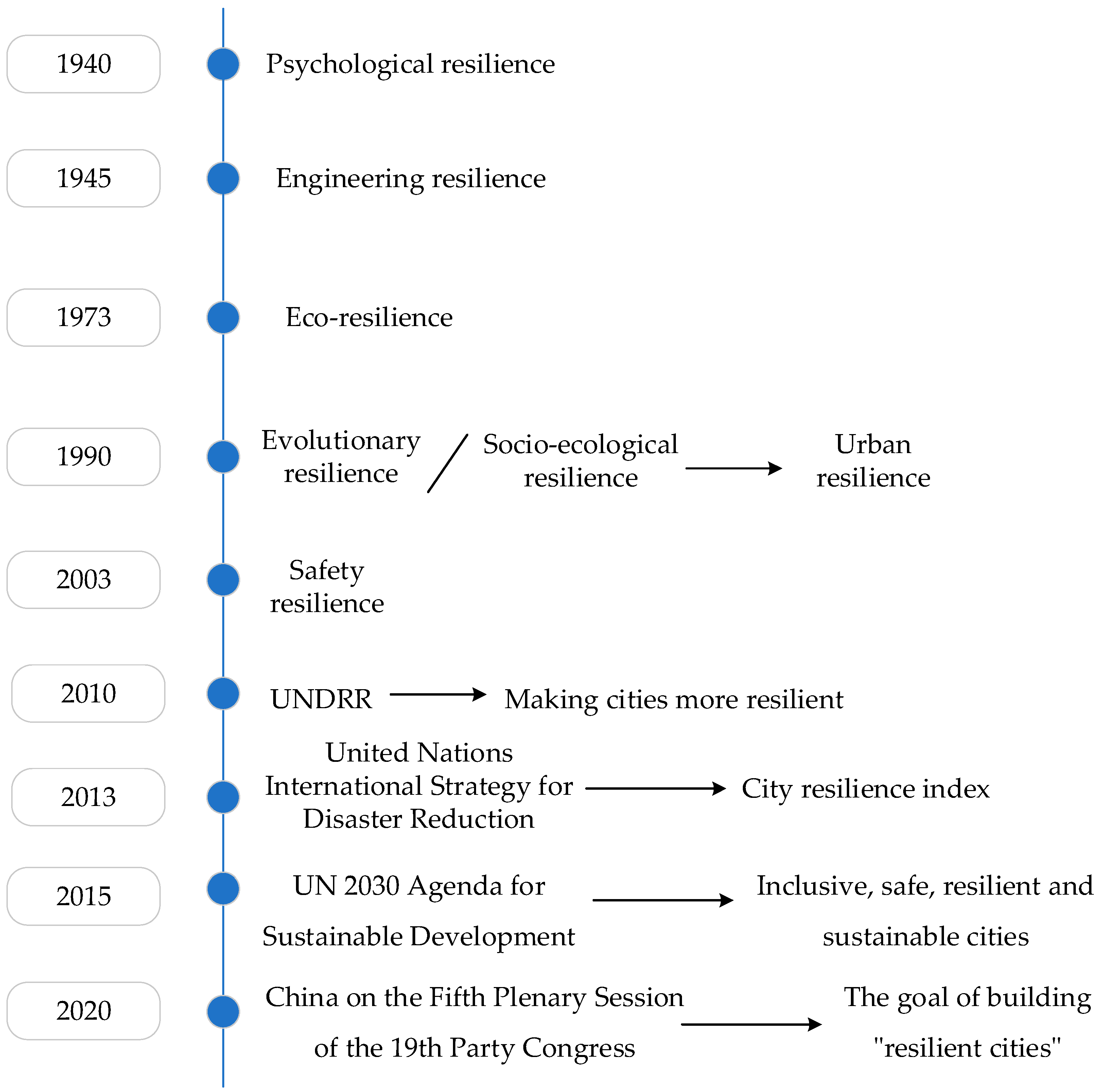

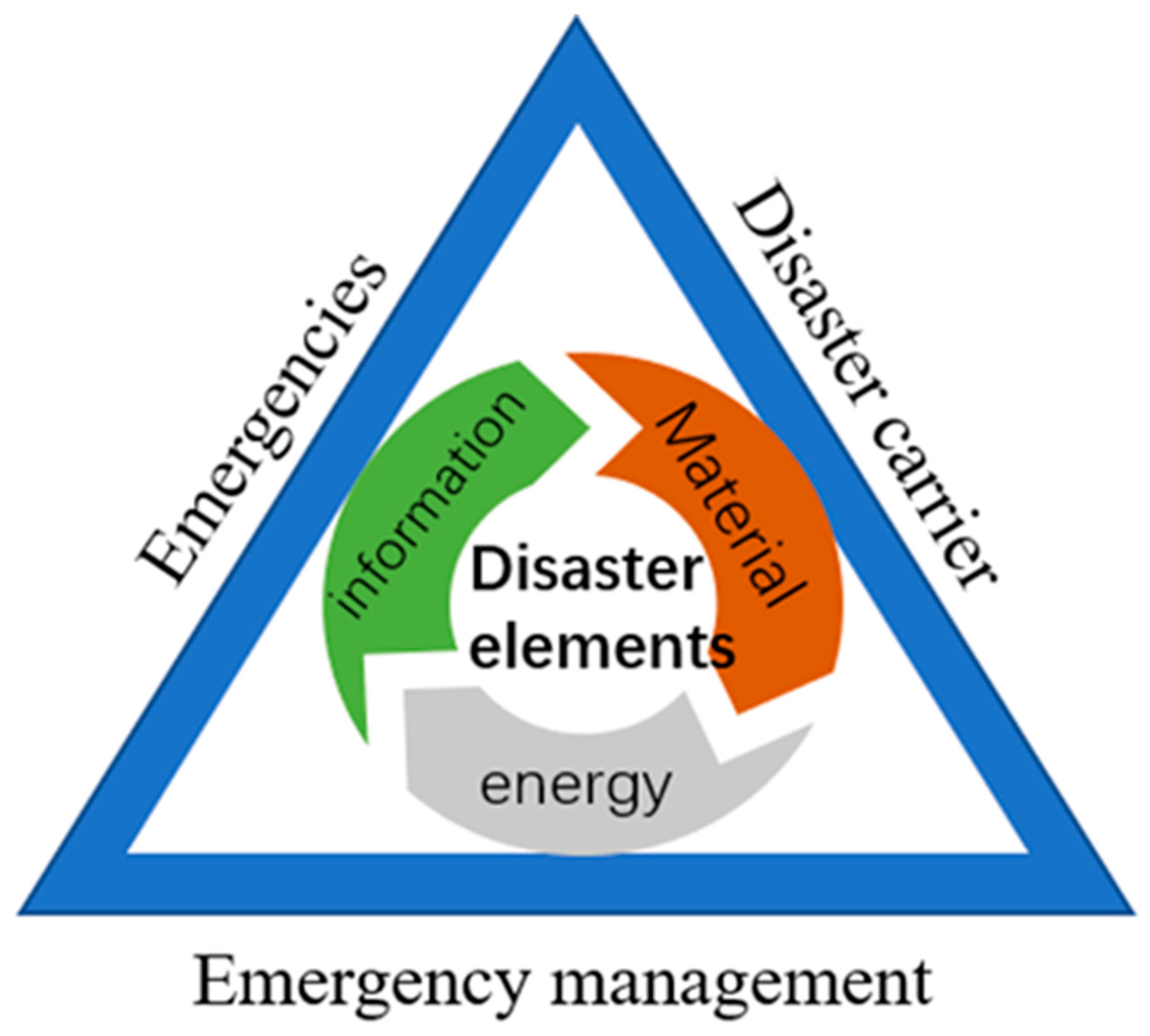
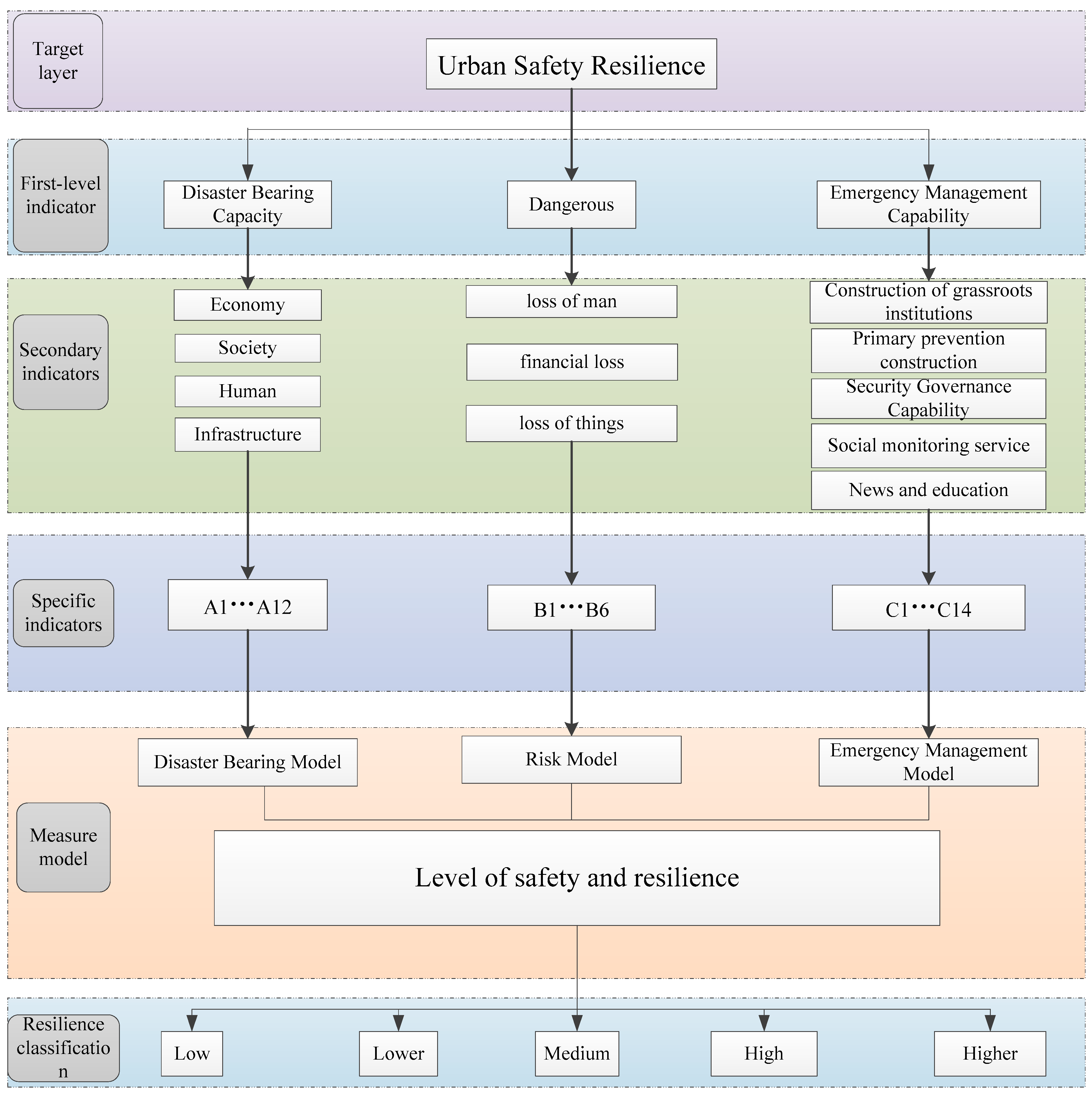
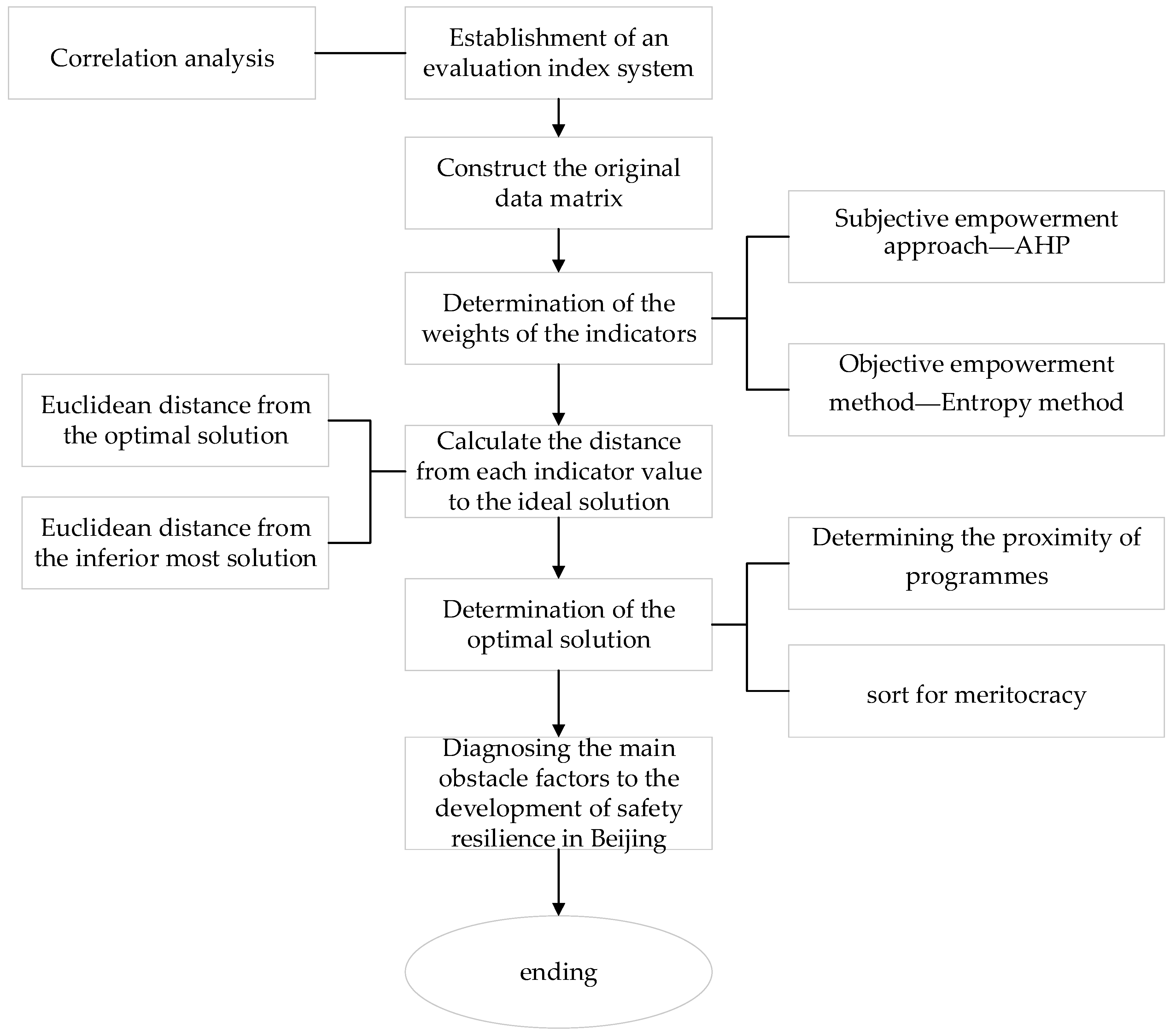
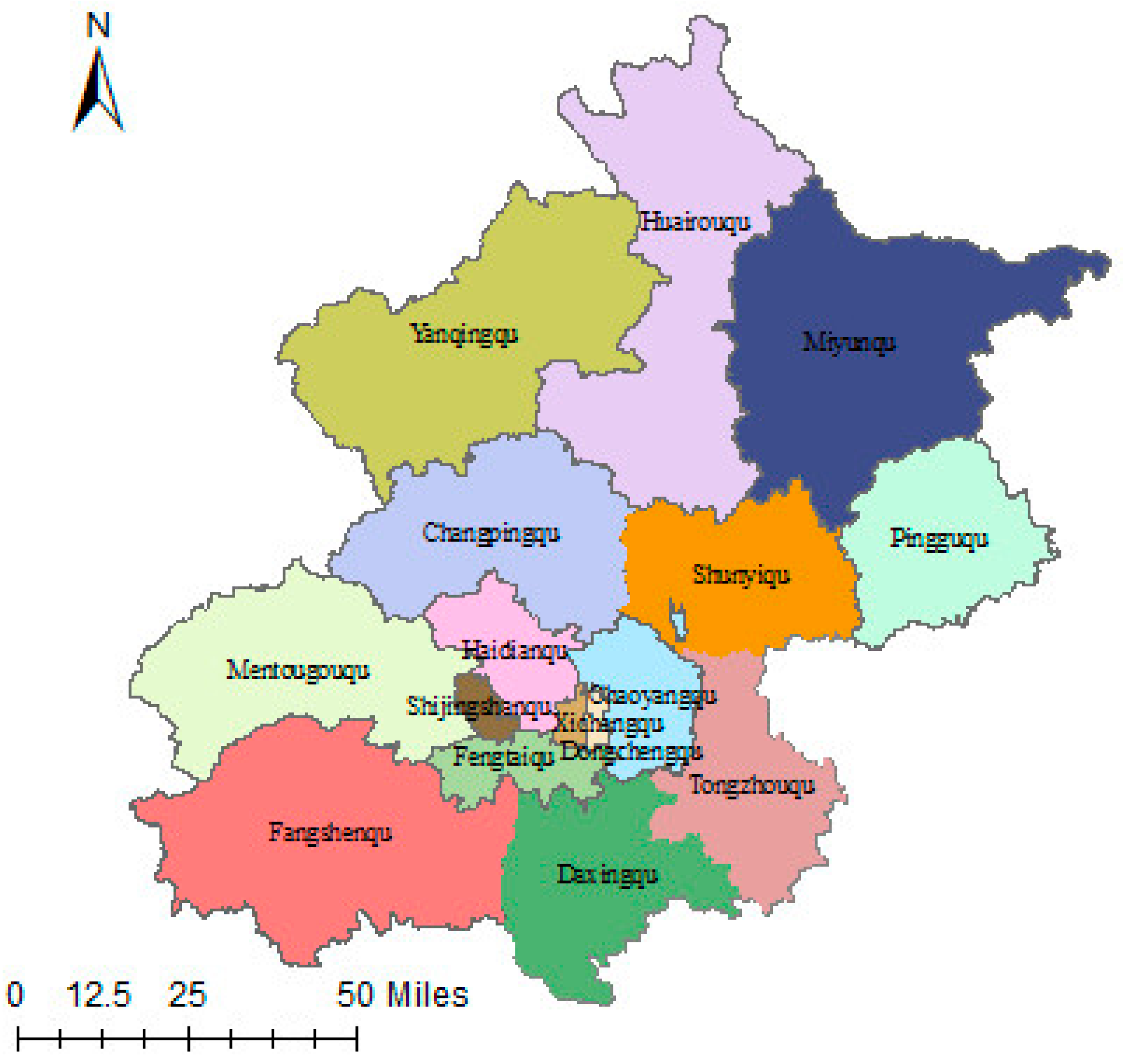



| The Range of Values of |R| | Degree of Relevance |
|---|---|
| 0.0~0.2 | Extremely weak or no correlation |
| 0.2~0.4 | Weak correlation |
| 0.4~0.6 | Moderate correlation |
| 0.6~0.8 | Strong correlation |
| 0.8~1.0 | Extremely strong correlation |
| Importance Level | Meaning | Illustrate |
|---|---|---|
| 1 | Equally important | The two factors are compared and have the same importance |
| 3 | Slightly more important | Comparing the two factors, one is slightly more important than the other |
| 5 | Obviously important | Comparing the two factors, one factor is clearly more important than the other |
| 7 | Very important | Comparing the two factors, one is much more important than the other |
| 9 | Extremely important | Comparing the two factors, one factor is more important than the other |
| 2, 4, 6, 8 | - | The median value of the above adjacent judgement |
| Reciprocal | - | Judgement aij comparing Factors i and j, then judgement aji = 1/aij comparing Factors j and i |
| Guideline Layer | Weights | CI Value | CR Value | Consistency Test Result |
|---|---|---|---|---|
| Disaster Bearing Capacity A | 0.5020 | 0 | 0 | Through |
| Danger B | 0.06 | |||
| Emergency Management Capability C | 0.439 |
| Factor Layer | Weights | CI Value | CR Value | Consistency Test Result |
|---|---|---|---|---|
| General public budget revenue (billion yuan) A1 | 0.058 | 0.028 | 0.018 | Through |
| Total actual utilization of foreign capital (USD million) A2 | 0.154 | |||
| Total industrial output value as a proportion of GDP (%) A3 | 0.031 | |||
| Urban registered unemployment rate (%) A4 | 0.008 | |||
| Ratio of social safety expenditure and employment to fiscal expenditure (%) A5 | 0.029 | |||
| Medical insurance participation rate (%) A6 | 0.045 | |||
| Resident population density (persons/km2) A7 | 0.01 | |||
| Number of students in general secondary schools per 10,000 people A8 | 0.03 | |||
| Natural population growth rate (‰) A9 | 0.044 | |||
| Per capita disposable income of residents (yuan) A10 | 0.04 | |||
| Number of hospital beds per 10,000 people (units) A11 | 0.035 | |||
| Urban per capita electricity consumption (KW·h/person) A12 | 0.018 | |||
| Number of accidents and disasters (cases) B1 | 0.012 | 0.003 | 0.002 | Through |
| Number of fatalities in production safety accidents (persons) B2 | 0.014 | |||
| Accident disaster direct economic loss (million yuan) B3 | 0.006 | |||
| The number of accidental disaster deaths year-on-year decline rate (%) B4 | 0.013 | |||
| Billion GDP mortality rate (%) B5 | 0.008 | |||
| Direct economic loss per capita (yuan) B6 | 0.007 | |||
| Emergency management agency personnel (people) C1 | 0.015 | 0.152 | 0.096 | Through |
| Number of professional emergency rescue teams (people) C2 | 0.038 | |||
| Disaster information officer (person)C3 | 0.022 | |||
| Earthquake Disaster Reporters and Geohazard Surveyors (person) C4 | 0.012 | |||
| Number of administrative law enforcement officers holding certificates (people) C5 | 0.029 | |||
| Administrative enforcement inspections per capita (pieces/person) C6 | 0.035 | |||
| Workload per full-time safety officer (home/person) C7 | 0.015 | |||
| Safety inspection coverage (%) C8 | 0.012 | |||
| The coverage rate of accident and hidden danger investigation and management systems (systems that use information technology for accident and hidden danger investigation and control) (%) C9 | 0.061 | |||
| Correction rate of accidents and hidden dangers (%) C10 | 0.01 | |||
| Coverage rate of safety risk assessment in key industry areas (%) C11 | 0.046 | |||
| Safety and liability insurance coverage (%) C12 | 0.034 | |||
| Number of safety training assessment personnel (people) C13 | 0.08 | |||
| Administrative law enforcement personnel training exam pass rate (%) C14 | 0.03 |
| Resilience Grade | Resilience State | |
|---|---|---|
| V | Very low | [0, 0.2278] |
| IV | Low | [0.2278, 0.2623] |
| III | Average | [0.2623, 0.2670] |
| II | High | [0.2670, 0.4872] |
| I | Very High | [0.4872, 1] |
| Districts and Counties | D+ | D− | Resilience Grade | Rank | |
|---|---|---|---|---|---|
| Chaoyang | 0.2296 | 0.4840 | 0.6783 | I | 1 |
| Haidian | 0.3286 | 0.4007 | 0.5494 | I | 2 |
| Dongcheng | 0.4310 | 0.3552 | 0.4518 | II | 3 |
| Xicheng | 0.4509 | 0.3089 | 0.4066 | II | 4 |
| Shijingshan | 0.5220 | 0.1873 | 0.2671 | III | 5 |
| Fengtai | 0.5098 | 0.1859 | 0.2673 | III | 6 |
| Fangshan | 0.5291 | 0.1911 | 0.2654 | III | 7 |
| Changping | 0.5122 | 0.1843 | 0.2646 | III | 8 |
| Shunyi | 0.5220 | 0.1873 | 0.2641 | III | 9 |
| Mentougou | 0.5431 | 0.1906 | 0.2598 | IV | 10 |
| Huairou | 0.5276 | 0.1780 | 0.2522 | IV | 11 |
| Daxing | 0.5226 | 0.1759 | 0.2518 | IV | 12 |
| Yanqing | 0.5022 | 0.1573 | 0.2385 | IV | 13 |
| Miyun | 0.5509 | 0.1601 | 0.2252 | V | 14 |
| Pinggu | 0.5513 | 0.1477 | 0.2113 | V | 15 |
| Tongzhou | 0.5567 | 0.1297 | 0.1890 | V | 16 |
| Dongcheng District | Xicheng District | Chaoyang District | Haidian District | Fengtai District | Shijingshan District | Mentougou District | Fangshan District |
|---|---|---|---|---|---|---|---|
| A11 8.69% | A11 7.86% | A11 9.23% | A11 6.22% | A11 6.84% | C13 7.21% | C13 7.54% | C13 7.81% |
| A6 8.23% | A8 7.37% | A8 8.11% | A8 5.78% | A6 6.31% | A1 6.37% | A1 7.17% | A6 7.04% |
| C2 7.15% | A4 7.06% | C10 7.50% | C3 5.55% | A4 6.15% | A12 5.97% | A4 5.43% | A4 5.74% |
| Changping District | Shunyi District | Daxing District | Changping District | Pinggu District | Huairou District | Miyun District | Yanqing District |
| A11 7.58% | A11 8% | B1 6.72% | B1 7.58% | C13 7.03% | B3 6.91% | C13 6.89% | C13 7.18% |
| A6 6.74% | B3 6.86% | B3 6.62% | A6 6.25% | A1 6.70% | A1 5.49% | A1 6.47% | A1 6.90% |
| A4 6.63% | A12 6.32% | A12 6.49% | A12 5.16% | A4 2.36% | A4 3.50% | A12 5.61% | A4 3.56% |
Disclaimer/Publisher’s Note: The statements, opinions and data contained in all publications are solely those of the individual author(s) and contributor(s) and not of MDPI and/or the editor(s). MDPI and/or the editor(s) disclaim responsibility for any injury to people or property resulting from any ideas, methods, instructions or products referred to in the content. |
© 2023 by the authors. Licensee MDPI, Basel, Switzerland. This article is an open access article distributed under the terms and conditions of the Creative Commons Attribution (CC BY) license (https://creativecommons.org/licenses/by/4.0/).
Share and Cite
Liu, L.; Pei, J.; Wang, H.; Luo, Y. The Evaluation and Obstacle Analysis of Urban Safety Resilience Based on Multi-Factor Perspective in Beijing. Land 2023, 12, 1918. https://doi.org/10.3390/land12101918
Liu L, Pei J, Wang H, Luo Y. The Evaluation and Obstacle Analysis of Urban Safety Resilience Based on Multi-Factor Perspective in Beijing. Land. 2023; 12(10):1918. https://doi.org/10.3390/land12101918
Chicago/Turabian StyleLiu, Lu, Jingjing Pei, Huiquan Wang, and Yun Luo. 2023. "The Evaluation and Obstacle Analysis of Urban Safety Resilience Based on Multi-Factor Perspective in Beijing" Land 12, no. 10: 1918. https://doi.org/10.3390/land12101918




